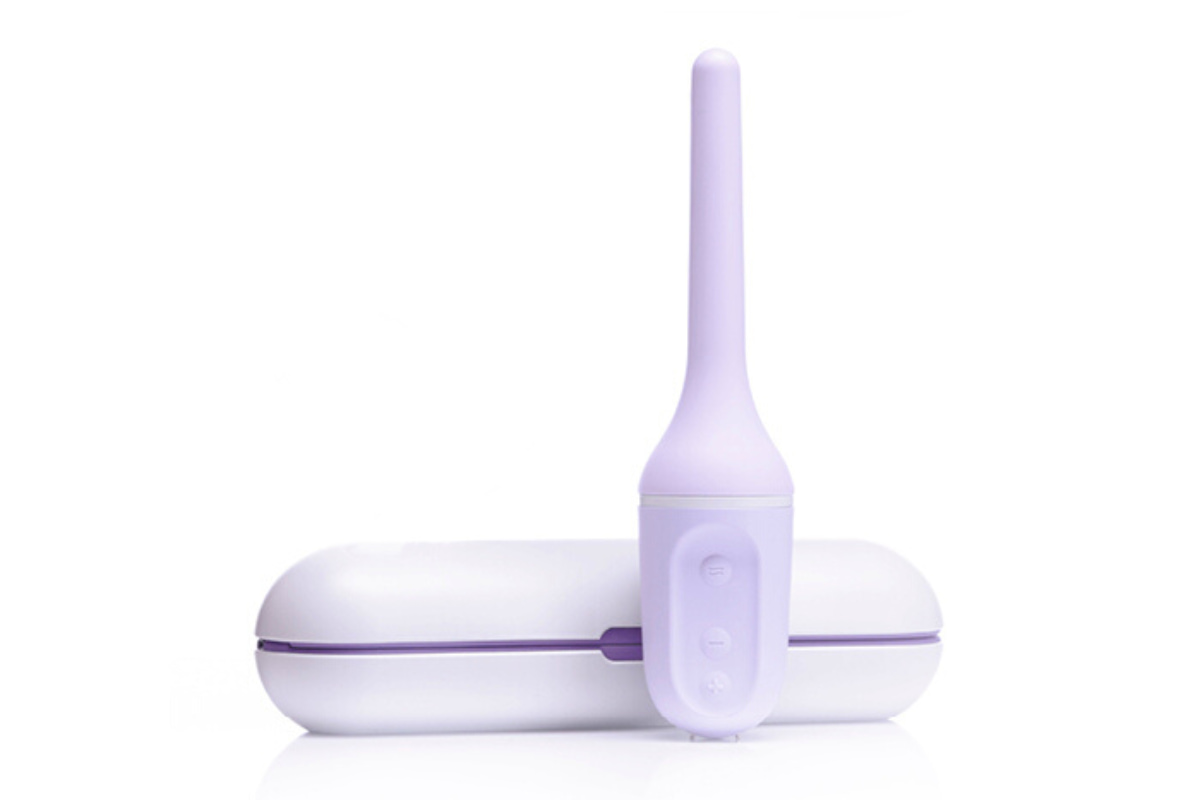Easing Painful Sex With a Vaginal Dilator

Menopause-related changes can cause sex to be painful. Some researchers estimate that about 29% of menopausal women experience pain during sex, although the number may be as high as 45%. Experiencing painful sex around the menopause transition is, unfortunately, a very common experience.
The good news is that you can make vaginal penetration comfortable by utilizing vaginal dilators and addressing hormone-related changes in the vaginal tissues.
What is a Vaginal Dilator?
Vaginal dilators (also known as vaginal trainers) are a therapeutic tool that is often used in treating painful vaginal penetration. They offer a self-paced method for systematically increasing your comfort with stretching the vaginal opening as well as deeper insertion.
Dilators can be made of silicone, plastic or glass. They are traditionally sold in sets that increase stepwise in diameter and length, but the option of a single expandable dilator is now available with the Milli Vaginal Dilator. Some people choose to create their own dilator set by purchasing progressively increasing sizes of vibrators and/or dildos from adult toy suppliers. The key feature of a dilator set is that you can find a size that is small enough to comfortably start with and have options to increase the challenge as your body adjusts.
Why Would I Need Dilators?
Low estrogen levels in peri-and postmenopause significantly change vaginal tissues. Almost all women experience some symptoms of genitourinary syndrome of menopause (GSM), including vaginal dryness, thinning of the vaginal tissues and narrowing of the vaginal opening. Understandably, feeling pain with penetration causes people to avoid doing it—which can compound a loss in tissue elasticity. If you haven’t already learned about GSM, make sure to read the article linked at the end of this page.
It’s appropriate to try dilators once you’ve been consistently treating GSM for a couple of weeks and seeing notable improvement in your symptoms.
When you experience pain with sex, your nervous system can learn to stay on high alert to “guard” against the anticipated pain—which unfortunately creates a higher likelihood of pain. Using a dilator can allow you to teach your nervous system that penetration is not a painful experience and gradually unlearn the guarding response.
Dilators do not solve GSM symptoms, but they can be a helpful tool to restore flexibility and decrease sensitivity with vaginal penetration when combined with consistent treatment of GSM.
Note: Some people experience pain with vaginal penetration unrelated to GSM. Physical and psychological trauma and abuse, childbirth, pelvic surgeries and repeated infections can all create a guarding response against penetration. Vaginal dilators are also an appropriate step in treatment for many of these cases.
How to Use Dilators
Everyone’s needs are unique. The main goal is to create a safe environment in which you can challenge yourself. If you feel significant pain or distress while using a dilator, it is likely too much too soon, and you may need to approach the process more slowly or with guidance. If you need help managing your dilator therapy, consult your healthcare provider and consider visiting a pelvic physical therapist for more in-depth assistance.
Setup
- Wash and dry the dilator(s) you will be using
- Find a quiet space where you can relax without being distracted
- Get into a comfortable position. For many people, this is lying on their back with their knees in a diamond/butterfly shape. Pillows under your head, upper back and knees will allow you to relax.
- Generously apply a lubricant to your dilator. If you are using a silicone dilator, you should not use silicone-based lubricant. Learn more about lubricants products by scrolling down and clicking on icons at the end of this section.
- Empty your bladder if you need to.
Using the dilator
- Choose a dilator size that you are able to insert with mild discomfort or feeling of resistance from your muscles. It should not cause pain, but if it goes in quickly and easily, you should probably go up in size. If you’re nervous about trying a larger size, it’s OK to start with one you’re confident in and gradually go up in size.
- Leave the dilator in place. For some, relaxing into the presence of the dilator inside the vaginal opening is helpful. You can use mindfulness techniques including controlled breathing to help your body relax. Breathe to Relax is a great place to start to learn how to control your breathing. Find it in the Wellness section via the Discover page in the Midday app.
- Practice contracting and relaxing with the dilator. A dilator can help you build awareness and coordination of the pelvic floor. Do a gentle pelvic floor contraction (Kegel) around the dilator and then fully relax. Repeat a few times to help relax into the presence of the dilator inside the vagina.
- Move the dilator. Some find it helpful to practice feeling the dilator move back and forth inside the vaginal opening. You can go at your own pace, working up to faster and deeper movement as you are comfortable.
Variations
Some people feel uncomfortable on their back with their legs apart. Dilators can also be used while lying on your side, standing with one foot on a step, seated on a toilet or any other variation that allows you to feel safe and relaxed.
Partners can be present and participate in dilator therapy sexually and non-sexually. Using a dilator during sexual intimacy can help bridge the gap between dilator therapy and penetrative sex. Some people report that they are more successful and motivated when pleasure and arousal are involved in their dilator practice, and others prefer to keep them separate. The decision is up to you, and you can change your practice with time and experimentation.
Tips
- In general, a 10-15 minute session 3-4 times per week is enough to see good progress without burning out.
- Use a maximum of 2-3 dilator sizes in a given session.
Sign up for more unique women’s health content
By submitting this form, you agree to the Lisa Health Privacy Policy and Terms of Use


